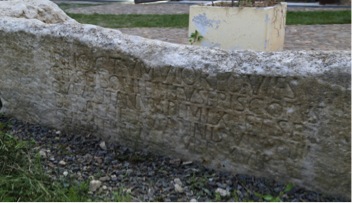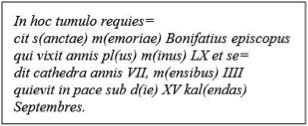Sarcophagus of the Bishop Bonifatius
The archaeological site of San Saturnino is located in the eastern part of the city of Cagliari, an area which in ancient times stood outside the city limits and was part of the necropolis extending east of the town, from today's Viale Regina Margherita up to the Bonaria hill. Here you can still see the surviving evidence of the necropolis and the Basilica dedicated to the martyr Saturnino.
Currently in the area in front of the domed building, near the western branch of the church, there is a limestone sarcophagus (figs. 1-4), partly worn, that was the original burial place of Bishop Bonifatius, as the Latin inscription in capital letters on one of the long sides states, and is dated 4th-5th century: Bishop Bonifacio, who died at the age of 60, was Bishop for seven years and four months (fig. 5).
According to the historian Serafino Esquirro, we know that this sarcophagus was discovered before the digs that began in 1614 in the basilica of S. Saturnino and that was used again as the altar in the chapel to the left of the apse.
The necropolis connected with the basilica was chosen as a burial place by several members of the ecclesiastical hierarchy during the 5th-6th centuries, probably as they wished to be buried near the martyr: the funeral inscriptions state a defensor (a lawyer who helped the bishop to manage the diocese), an archipresbiter, a notarius subregionarius et rector (a depository of public deeds and close collaborator of the lawyers), a clericus and perhaps a lector. Other ecclesiasticals are mentioned in the seventh century transcriptions.





Bibliografia
- CA.M. CORDA, Le iscrizioni cristiane della Sardegna anteriori al VII secolo. Studi di antichità cristiana, LV. Città del Vaticano 1999.
- R. CORONEO, Sarcofagi marmorei del 3.-4. secolo d'importazione ostiense in Sardegna, in R.M. Bonacasa, E. Vitale eds., La cristianizzazione in Italia fra tardoantico e altomedioevo”. Atti del IX Congresso Nazionale di Archeologia Cristiana (Agrigento, 20-25 novembre 2004), Palermo 2007, pp. 1354-1368.
- S. ESQUIRRO, Santuario de Caller, y verdadera istoria de la invencion de los cuerpos Santos hallados en la dicha Ciudad y su arzobispado, Caller, doct. Antonio Galçerin, por Juan Polla, 1624.
- R. MARTORELLI, Le aree funerarie della Sardegna paleocristiana, in P.G. SPANU ed., Insulae Christi: il Cristianesimo primitivo in Sardegna, Corsica, Baleari. Mediterraneo tardoantico e medievale: scavi e ricerche, 16, Cagliari-Oristano 2002, pp. 315-340.
- D. MUREDDU ET ALII, Sancti innumerabiles. Scavi nella Cagliari del Seicento: testimonianze e verifiche, Oristano 1988.
- D. SALVI, Cagliari: San Saturnino, le fasi altomedievali, in P. CORRIAS, S. COSENTINO eds., Ai confini dell’Impero. Storia, arte e archeologia della Sardegna bizantina, Cagliari 2002, pp. 225-229.
- D. SALVI, Cagliari: l’area cimiteriale di San Saturnino, in P.G. SPANU ed., Insulae Christi: il Cristianesimo primitivo in Sardegna, Corsica, Baleari. Mediterraneo tardoantico e medievale: scavi e ricerche, 16, Cagliari-Oristano 2002, pp. 215-223.

 VR
VR